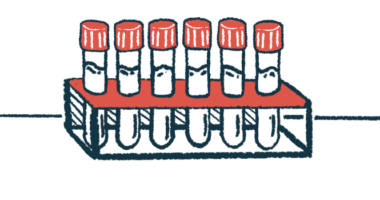Noninvasive eye imaging technique may aid early FAP detection
CCM helped evaluate corneal nerve fiber density, length, immune cell infiltration

Changes in the nerve fibers of the cornea — the eye’s clear protective outer layer — may help in the early diagnosis of hereditary transthyretin amyloidosis (hATTR), a group of disorders that includes familial amyloid polyneuropathy (FAP), a study shows.
A noninvasive imaging method, called corneal confocal microscopy (CCM), identified a marked loss of nerve fibers in the cornea of both hATTR patients (including those with FAP) and presymptomatic carriers, people with hATTR-causing mutations but no overt symptoms.
These findings suggest “CCM could be a sensitive diagnostic tool to enable early diagnosis and to monitor mutation carriers, even earlier than currently recommended following the PADO [predicted age of disease onset] concept,” the researchers wrote.
Following up with carriers is recommended to start 10 years before the predicted PADO, based on the disease-causing mutation and age of onset of affected family members.
The study, “Corneal confocal microscopy identifies corneal nerve loss and increased Langerhans cells in presymptomatic carriers and patients with hereditary transthyretin amyloidosis,” was published in the Journal of Neurology.
hATTR is a group of progressive conditions caused by mutations in the TTR gene that provides instructions for making the transthyretin (TTR) protein. The mutations cause abnormal TTR to accumulate into toxic clumps into various tissues.
FAP, a form of hATTR, is mainly marked by peripheral neuropathy, or damage in the nerves outside the brain and spinal cord. The toxic aggregates can also damage the heart, kidney, and the eyes.
In fact, eye abnormalities, including in the cornea, have been suggested as early biomarkers of FAP, which would allow for earlier treatment and disease monitoring. Assessing changes in the eyes’ small nerve fibers is challenging, however.
The cornea is innervated by a dense network of sensory nerves. Lower nerve fiber density indicates nerve damage or dysfunction; lower nerve fiber length is another measure of poor corneal nerve health.
Corneal confocal microscopy is a rapid, noninvasive ophthalmic imaging technique that uses a high-resolution microscope to capture images of the cornea and the nerve fibers within it.
The obtained images allow the length and density of the nerve fibers in the cornea to be calculated and nerve fiber loss to be assessed, along with the infiltration by immune cells into the cornea.
Changes in corneal nerve fiber length, density
The technique has shown diagnostic value in several peripheral neuropathies, including those triggered by a dysfunctional immune system. However, “data on CCM in patients with [hATTR] are scarce,” wrote the researchers at the University Hospital Essen, Germany, who evaluated its potential for its early diagnosis.
The study included 20 hATTR patients (15 men, five women; mean age, 64.1), five presymptomatic carriers (three women, two men; mean age 40.4), and 20 age- and sex-matched healthy people, who served as controls. Presymptomatic carriers were relatives of the patients.
A total of 14 patients were classified as having FAP, while the remaining six had hATTR-related heart disease (cardiomyopathy).
The researchers used CCM to evaluate corneal nerve fiber density (CNFD), corneal nerve fiber length (CNFL), and the infiltration of immune cells close to the fibers.
Results showed the mean CNFD was significantly lower in hATTR patients (21.05 fibers per square millimeter, or fibers/mm2) and presymptomatic carriers (19 fibers/mm2) than in healthy controls (30.75 fibers/mm2).
Significant CNFD differences between patients and healthy controls were true for both FAP patients (20.36 fibers/mm2) and the subset of patients with cardiomyopathy (22.67 fibers/mm2).
The mean CNFL was also significantly lower in hATTR patients relative to healthy people (12.95 vs. 17.4 mm per mm2, or mm/mm2). This was specific to FAP patients (12.71 mm/mm2) as no significant differences were found for the cardiomyopathy group. The presymptomatic group also had comparable mean CNFL to healthy controls.
Higher levels of immune cell infiltration
Moreover, hATTR patients had a significantly higher mean number of infiltrated immune cells, termed nondendritic cells with fiber contact (NFC) than healthy controls (11.8 vs. 2.3 cells/mm2). No such difference was seen between presymptomatic carriers and healthy controls.
A higher number of these cells was significantly associated with lower corneal nerve fiber density in hATTR patients.
The researchers later confirmed the so-called nondendritic cells are immature Langerhans cells — a unique population of tissue-resident immune cells — based on their shape.
“Our findings suggest that CCM may identify the onset of subclinical amyloid neuropathy in presymptomatic carriers, as there was a striking loss of nerve fibers in carriers who were approximately [20] years younger than their relatives with apparent amyloidosis at disease onset,” the researchers wrote. “CCM may therefore qualify as a predictive surrogate marker to identify presymptomatic carriers at risk of developing ATTR related neuropathy.”
Also, “corneal immune cell infiltration could be used to differentiate between presymptomatic carriers and symptomatic patients, as significant corneal immune cell infiltration, namely an increase in NCF, only occurred in the latter,” the researchers wrote, noting more research is needed to “assess the predictive value of CCM.”







